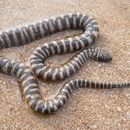en
names in breadcrumbs


The snake family Acrochordidae includes just a single genus, Acrochordus. All three Acrochordus species are fully aquatic snakes found in the Indo-Australian region.The three extant (i.e., not extinct) species have loose-fitting skin and non-overlapping granular scales (hence the common names "filesnakes" and karung (=sack in Indonesian)). Acrochordus display many behavioral, anatomical, and life-history traits that are unique or unusual among living snakes, including highly developed scale sensillae; a derived cranial morphology; very high blood volume; and extremely low rates of metabolism, growth ,and reproduction. Recent morphological and molecular analyses of snake phylogeny place Acrochordus as sister to the highly diverse Colubroidea, a clade that includes ~2500 species, 85% of extant snakes.
The three extant Acrochordus species exhibit differences in their ecology, scalation, and anatomy. Acrochordus granulatus, which was previously classified in a separate monotypic genus (Chersydrus), are the smallest Acrochordus (~1 m in total length). Acrochordus granulatus is also the most widely distributed species, reported from coastal northwest India to the Solomon Islands in diverse habitats, including freshwater lakes and rivers, mangroves, mudflats, reefs, and open sea (up to 10 km offshore and at depths of 20 m). Acrochordus javanicus are large and heavy-bodied (exceeding 10 kg and 2 m total length) and are found in freshwater (and sometimes brackish) habitats in southern Thailand, Malaysia, Sumatra, Java, and Kalimantan, where they are harvested on a large scale for the reptile skin trade. Acrochordus arafurae was not recognised as a species distinct from A. javanicus until the late 1970s. Acrochordus arafurae have a similar total length as A. javanicus, but are much less heavy-bodied, being nearly half as heavy at the same snout-vent length. Acrochordus arafurae occurs in exclusively freshwater habitats of northern Australia and southern New Guinea.
(Sanders et al. 2010 and references therein)
A blog about snake natural history, ecology, and evolution